Anatomy of failed marine helicopter doctrine equipment and tactics
By Michael Sparks, a former enlisted and officer marine
Introduction

C-SPAN recently aired a simulated helicopter raid on a terrorist camp by marine corps (Mc) infantry grunts from "L" (Lima) Company 3rd Battalion, 5th marine regiment at Camp Pendleton, Ca. If the performance of these Lima Company men (Blue Forces or "BlueFor") against a non-threatening opposing force (OPFOR) are indicative of the state of readiness of other marines (and I think it is because much of their mistakes are systemic) then we will have heavy casualties if the marines in Afghanistan meet determined, skilled resistance by Taliban and Al Queda, or other terrorists or enemies.
The raw video footage:
http://video.c-span.org:8080/ramgen/ldrive/ter112601_marines.rm
Please view the clip in its entirety before proceeding!
My perspective
After spending nearly a decade of my life trying to reform the marines, watching the program was depressing in that it appears nothing has really changed since my time (1981-1993) and the only bright spot is now I have at least a visual record which I can scrutinize to better illustrate what I have been fighting against, for all who want to know the truth. It seems that a new crop of impressionable young men replaces the old and bad ideas and practices are perpetuated.
However, unless the Mc repudiates its current corrupt, arrogant values and embraces technotactical humility there is no hope for any of the following being fixed. The Mc will remain a haven for weak co-dependants to congregate, take on airs of superiority and congratulate themselves on how great they are--- measured by their own fake internal standards. You can see all of this in one relatively tiny clip of video footage! A microcosm of the Mc in action!
Lima's Simulated Mission
Since America is at war with terrorists, the Mc will try to make itself useful by applying its own simplistic "cookie-cutter" methods to finding and killing terrorists.
But why put men on ground?
1. To thoroughly destroy terrorists since air strikes will not kill them all
2. Capture intelligence items to get clues as to where the hiding terrorists are and what they are capable and intending to do since airstrikes cannot collect things from the ground
FM 90-4 Air Assault operations states a tactically sound Ground Tactical Plan (in this case, to raid a terrorist camp) should drive the Airlanding plan. But this was not done in this raid.
Poor concept of operation
Lima Company is to helicopter raid a simulated terrorist camp held by about a Mc squad (13 men) of OPFOR wearing 3-color tan/brown camouflaged desert battle dress uniforms (BDUs). A base-of-fire (BOF) will be set up by Weapons Platoon after a helicopter insertion. An AH-1W HueyCobra helicopter gunship will fire the target up, followed by the BOF element inserting behind a small hill top and moving forward to open and sustain 7.62mm medium machine gun and 60mm mortar fire on the objective. The assault force will then land directly on top of the objective by helicopter and kill off the remaining terrorists and capture any documents of intelligence value, afterwards the entire force will withdraw by helicopter. The Mc has only two tactics, frontal assault or single envelopment. In their narrow world this is all there is.
Unrealistic, weak OPFOR target
First, the terrorist camp is placed on flat ground in the open where it has no tactical advantage. It's clearly seen from the air by the helicopter pilots to land nearby. Tactically advantageous high ground is conveniently not defended and thus, available without a fight for the BlueFor to use. A smart enemy wouldn't do this.
Weak, unprofessional OPFOR with no concept of cover


The OPFOR on the mock terrorist camp do not dig-in or camouflage themselves. They are not trying very hard to stay alive and stop the BlueFor. Those that do put up some resistance, fire from some thinly vegetated trees from a standing position before running away. This reveals a weakened understanding of the effects of actual bullets that require COVER to stop them, not just concealment. Because they know their blanks are not tied in to any kind of MILES laser tag system to assess casualties and damages or referee action, OPFOR knows they cannot hurt the BlueFor, so its just for show and spectacle. How can ANYTHING that the OPFOR does STOP the BlueFor? There is no real resistance they can offer, even if its obvious that OPFOR with real bullets would have blasted them. This is all make-believe.
Just a mistake made in training? Think again. November 29, 2001, marines in Afghanistan: where is the overhead cover?



Why are two marines that are NOT DIGGING, not wearing kevlar PASGT helmets but standing in the open "supervising"? The one on the right is not wearing his PASGT body armor or holding his weapon, either. None of the men have their bare skin camouflaged. Both are candidates for a sniper's bullet or mortar/rocket shrapnel killing them. Yet this is a "REAL" combat mission. You fight as you train.
Back to the training exercise.
Ad Hoc OPFOR not taking assignment seriously



Fun and games.
Both OPFOR marines are not camouflaged, nor dug-in. Both remark how they have gone to bars since the 9/11 attacks and now get free drinks. Clearly, their minds are not on their profession. Their "782" gear ("TA-50" in Army parlance) are not taped, silenced and camouflaged. The bright red Blank Firing Adapters (BFAs) on their rifles are not subdued with tape. They are easy "straw men" for BlueFor to spot and kill.
Just a mistake made in training? Think again. December 3, 2001, marines in Afghanistan: where is the noise and light discipline?



Got any marshmallows?
It's assumed that no enemy are on outposts on key terrain surrounding objective...

The raid begins by a HueyCobra gunship coming to a hover about 50 feet above the BOF hilltop area and notionally firing on the terrorist camp. A skilled enemy would outpost the key elevated terrain ringing his camp not leave it undefended--again the Mc sin of using "strawmen" easy-to-kill and make-us-feel-good-about ourselves OPFOR. In a real life attack, the unarmored Cobra could have been shot down by small-arms fire or a RPG fired from the enemies on the outpost. For a real-world example, 2 Cobras were shot down in Grenada trying to attack a fixed target against an alert enemy.
Corrections: helicopter gunships should not appear to alert the enemy until after the men on the ground are in assault and support-by-fire positions. They also need to train on running attacks to minimize vulnerability to enemy fires not just from a hover.

Next, the Weapons Platoon lands by CH-53E helicopter behind the hill mass, at least masked from direct enemy line-of-sight from the camp's tents. However, the helicopter would have been destroyed upon landing by any enemy on the key terrain, small-arms fire killing the men inside, destroying the engines and puncturing fuel cells and setting off a fire and/or explosion. Clearly, the helicopters carrying the BOF are landing too close to the objective, alerting the enemy and getting themselves destroyed. But this reality is not learned by the marines because the terrorist camp is being defended half-assed by a strawman OPFOR. Even if OPFOR was defending on the key terrain, there is no MILES gear or referees to force the helicopters to be shot down to learn a mistake was made.
Because the U.S. military in general poorly simulates mortars (except at JRTC where there are human firemarkers), the fact that OPFOR could have dropped mortar rounds (directed by radio or wire signals) on top of the huge spinning rotors of the CH-53E and destroyed it and everyone inside is not simulated or realized. OPFOR laying wire and employing mortars is more effort for people we want to offer just token resistance and die. The training is for the good guys, not them according to most excuses.
Corrections: men should be inserted out of hearing and sight of the objective and speed march to close in assault positions. Security Forces with eyes on the target take out enemy outposts at the right time so assault and BOF elements can take position. Speed marches via good combat instead of sports conditioning [www.reocities.com/equipmentshop/apft.htm] can be dismounted or mounted in light tracked AFVs with stealthy band tracks and possibly hybrid-electric drives or mountain bikes and carts.
Details:
www.reocities.com/air_mech_strike
www.reocities.com/pentagon/5265/atb.htm
www.reocities.com/equipmentshop/m113combat.htm
Its unwise to assume prep fires will kill or suppress all enemies near or on the objective. Remember that you want to capture something, not destroy everything. If you insist on landing directly onto the objective, do this in an armored and robust helicopter like a UH-60 Blackhawk not a fuel-laden, huge and unarmored CH-46 or CH-53E. The V-22 should be cancelled and battle-resistant UH-60s purchased. If more speed/range is needed for ship-to-shore operations add wings and a Piasecki vectored thrust ducted tail propeller.
Poor dismounted movement techniques


A "herd" instinct has taken over as the BOF realizes it has to move forward to get weapons effects onto the objective. Not only are the marines bunched together, making them an easy-to-kill target by just one landmine/unexploded ordnance being stepped on or mortar or grenade landing near them, they are not moving by BOUNDS when obviously they are in dire danger of enemy contact. Successive bounds and alternating bounding overwatch are NOT movement techniques employed in the Mc "book", at least not during my decade in the marines, and if its in the marine battle skills training (MBST) books, its a technique obviously not employed. The OPFOR in the prone depicted above clearly shot and killed the 2 marines running down the hill but again, no MILES, no referees; no honest tactical lessons learned.
Just a mistake made in training? Think again. November 29, 2001, marines in Afghanistan: bunched together in a war zone!




Here in the world's most heavily mined area, overloaded marines bunch together...parked helicopters are bunched together....didn't anybody study the attack on Pearl Harbor or watch the movie, "Tora! Tora! Tora!"?? Or unless its covered taught in the Guidebook for marines gyrenes don't know about it?
Poor Base-Of Fire positions


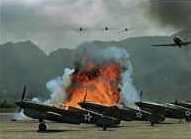
If the enemy can see you, he can hit you with his machine guns, too. Instead of pulling up just below the crest of the hill (minimum defilade) position to fire medium machine guns, the BOF element is in the open visible to even the CSPAN cameras. Such a position could be swept by the enemy's own machine guns, preventing the BOF from setting up by killing them. Afghan fighters that used man and mule-packed long-range mortars and rockets to pummel the Russians would know the importance of controlling terrain by fire not just sitting on it. Details:
The Bear Trap
www.afghanbooks.com
Corrections: employ minimum defilade and reverse slope machine gun firing positions to maintain secrecy until the last possible moment and keep the BOF element alive. Dig in when possible, but realize enemy security elements will at least have OP/LPs if not outpost in force key terrain where a BOF element could place effective fire on a camp. Silent sentry removal techniques must be taught, practiced and factored into plans or else deliberate attacks and raids will be spoiled by enemy security forces (re: Seal Team 4's attack on Punta Paitilla airport in Panama).
How will the 60mm mortars fire?
Will M224 60mm mortars with a mere 3.5 km range even reach the objective? How will they be aimed if they must be direct layed and see their targets if they are behind a hill mass? How many 60mm rounds will be carried and WHO will carry them? This was not simulated.
Corrections: All-Terrain All-purpose Carts (ATACs) should be purchased and used to transport mortars and ammunition. Simulated ammo loads should be transported during ALL training exercises. Pointer hand-launch electric UAVs could covertly target for mortars that stay hidden behind masking terrain for surprise fires that effectively destroy the enemy.
Details
www.geocities.com/pentagon/5265/atac.htm
Just a mistake made in training? Think again. November 29, 2001, marines in Afghanistan: how will you carry 60mm mortars if you have to displace to a new firing position?

Marine 60mm mortarman without a sling to carry his M224 60mm mortar prior to flying into Afghanistan even though publications encourage units to make slings from M60 MMG slings
Helicopters landing on top of enemy positions

Because infantry are needed on the ground to search for and capture documents to gain intel, they must get to the objective somehow. With slow, 1-4 mph foot mobility, the infantrymen of Lima Co decide to land the assault force by helicopter directly on top of the objective so they do not have to walk long distances and take time, but clearly within the effective small-arms fire range (less than 300 meters) of the living OPFOR enemies. However, the OPFOR are half-ass, do not have MILES gear, are not dug-in (Mc has no overhead cover TTP) to simulate how a skilled enemy would resist a heliborne raid as the Viet Cong did on January 2-6, 1963 at the Battle of Ap Bac. Interestingly enough, in that battle the tandem rotor forerunners of the Piasecki CH-46, CH-21 helicopters---were landed by U.S. Army pilots by technotactical mistake too close to the enemy-held treeline and taken under effective small-arms fire, resulting in 3 helicopters shot down, to include 1 Huey gunship trying to suppress. How history repeats itself!
www.geocities.com/equipmentshop/johnpaulvann.htm


Reality: what happens when a marine CH-46 tries to land too close to enemy weapons fire from Vietnam, Operation Hastings
Corrections
OPFOR firing at two CH-46 helicopters that landed too close; without MILES or referees the helicopters will not be destroyed to correct this error
At this point, both of the CH-46 helicopters, without armor protection would have been destroyed by gunfire and set ablaze before any of the marines could have gotten out. But because of half-assed training this lesson is not learned and the Mc continues to fund expensive and vulnerable V-22s rather than come to grips with the whole point of airlanding troops: what they are going to do on the ground (the Ground Tactical Plan). If all they are going to do is die in flaming aircraft wreckage's than we are not achieving anything but more body bags for the Mc propaganda machine to praise. The Mc is more interested in insuring institutional survival by a foot-in-the-door of a long ranged V-22 to assure they can reach shore than to fund a small light tracked armored vehicle which could fit inside fast compound helicopters, and be landed a safe distance from the objective so it can be over-run by ground vehicle armored shock action.
Just a mistake made in training? Think again. November 29, 2001, marines in Afghanistan: where are the helicopter transportable tracked armored vehicles?
NO! The whole point of U.S. Navy ships is that they can carry heavy armored vehicles, yet the Mc packs amphib ships with a quasi-light infantry force structure equipped with primarily vulnerable soft-skin, rubber tired trucks; such forces can be flown easily by aircraft from CONUS if required; so what does the Mc offer that an Army Light Infantry force doesn't? British Royal Marines are buying armored versions of the U.S. Army SUSV which can fit INSIDE helicopters, a better use of money than multi-billion dollar V-22s which will not work--so men can move through mined and enemy threatened areas under armor protection
Corrections
 YES!
YES!
Cluster **** at the CH-46 rear ramp
The phrase popularized by Clint Eastwood in the Mc falsely congratulatory film, Heartbreak Ridge applies here as the Lima Company assault force congregates at the rear ramp of the CH-46 awaiting directions from their leader what to do. This is institutional weakness when you compare it to U.S. Army Air Assault TTP honed over years of hard-fought and learned lessons in battle. The proper thing to do is immediately forming a hasty perimeter around the aircraft to return fire on the enemy SO THE AIRCRAFT CAN SURVIVE TO FLY AWAY.
Corrections: adapt U.S. Army Air Assault landing immediate actions TTP ASAP.
Flying over the enemy camp after insertion


After inserting the assault force, the CH-46s fly directly over the camp making it easy for the enemy to shoot a large, helicopter target broadside.
Corrections: don't do this.
No Command & Control: "Do what I say, damn it!"


The Mc weak on TTP, teaches its young to be weak co-dependants who must be told constantly and exactly what to do and when to do it every second of the day. So under the roar of helicopter engines the leader tries to shout/curse to the men to "get moving". If there were the additional noise of enemy gunfire, would he have even been heard? Where are the hand & arm signals?


The Army fireteam Leader is better because he is on point and the other team members act off of his visual, personal example. The Mc fireteam leader has a pointman (Rifleman) who has to constantly look back to him for directions and this ruins his concentration for signs of enemy and mines/booby-traps plus 2 others (Automatic Rifleman and Grenadier) to steer and direct by some kind of SIGNAL.
Corrections: Leaders should use whistles and other signals to control men in noisy areas. Do not expect voice commands to be heard in battle. Adopt the Army-style fireteam leader who leads-by-example from the point in dismounted formations.
Where were the rehearsals to promptly exit the helicopter and get moving towards the objective? More ad hocery and "we will wing it".
Corrections: Rehearsals. Do them. Base them on sound TTP not follow-the-leader herd instinct.
Was there even much firing of blanks by the assault force? Did you see any magazine changes? Or was this glossed over so weapons would be cleaner for an easier time and less hassle turning them into nit-picking marine armorers?
You fight as you train.
If you do not train to fire your weapon, reload and move you will not be good at it when you need to in combat.
No screening smoke


Landing men in the open, enemy small-arms fire would have wiped them all out when they congregated at the rear ramp and later. Where were the smoke grenades to at least conceal them from being OPFOR aim points? One of the marines fired a pop-up rocket flare, so there was no safety restrictions to using pyro. Did anyone request smoke grenades?
Poor fire & movement to objective
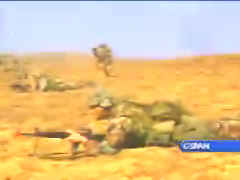
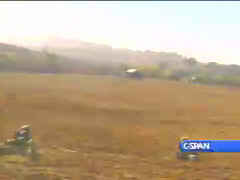
The Mc does not have a proper Individual Movement Technique (IMT) TTP like the U.S. Army has. You should either low-crawl, high-crawl or do 3-5 second rushes automatically as an individual Solider, not wait for commands from leaders. The marines here sit and wait for directions from their unit leaders, sitting in the open exposed to enemy fire! When they do move, they expose themselves to enemy fire in long 10-20 second rushes as the squad leader is depicted above. Because there is no MILES or referees, bad practices like this go unnoticed and uncorrected. Making matters worse, they cut in front of each other's firing lanes, which in a live-fire (like combat) would result in them getting wounded or killed, by friendly fire.
Poor equipment wear/usage: unsecured CAMEL-BAK drinking tube distracts squad leader
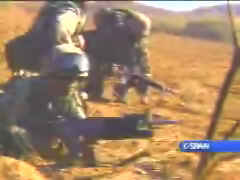
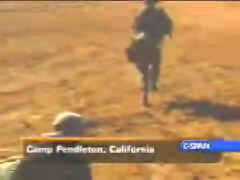

Leader has not "squared away" his own personal 782 gear to better focus on leading his men. This should have been figured out before the FTX.
Poor equipment wear/usage: M40 Pro Mask flopping around loose


Here, the Squad Leader has his M40 FPM flopping around loose. Clearly he hasn't read the instructions manual to have properly donned the mask and carrier. Not only is it slowing his movement, it could snag on vegetation resulting in him getting stuck and killed by enemy fire. If his CH-46 helicopter should crash in the water, it could prevent him from getting out of the escape window/hatches. marines have died from helicopter ditching in the sea from 782 gear snagging.
Corrections: U.S. Army Natick Labs are also to blame for a case that is too big because they want it to also house the M42 mask with a hose for mounted Soldiers to use. There are fixes to this:
www.reocities.com/equipmentshop/fpm.htm
Just a mistake made in training? Think again. November 29, 2001, marines getting ready to fly into Afghanistan: M240G 7.62mm Medium Machine Gunner holding extra ammunition in two heavy ammo cans instead of assault packs--also why camouflage yourself if you are going to put a full-color U.S. flag on your chest? Glare off goggles could alert enemy snipers to shoot and kill him. Corrections:
www.rgeocities.com/equipmentshop/pab.htm
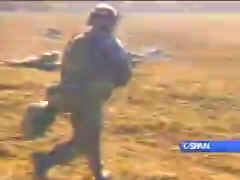
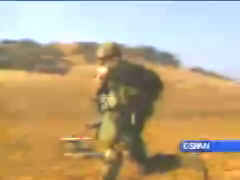
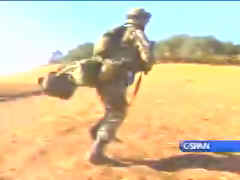
Poor equipment wear/usage: torn helmet covers and no camouflage!
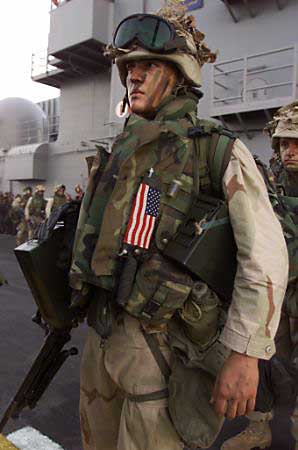
Platoon Sergeant (?) with torn helmet cover--why didn't he go to unit supply, post exchange, clothing sales, order from Ranger Joe's etc. and get a new cover for under $5.
Why are none of the assault force marines wearing camouflage paint?
Hands and exposed skin not covered by gloves and bandanas?
Helmets not camouflaged by burlap or vegetation stuck in helmet cover slots or helmet bands?
His helmet camouflage band is not tied down with 550 paracord and about ready to fall off.
These are not squared-away warriors.
Who did pre-combat inspections (PCIs) for this unit?
Corrections: Do PCIs to higher, U.S. Army Expert Infantry Badge (EIB) standards or better. Attach "ragtop" helmet covers like some of the 15th MEU marines have done for Afghanistan. Secure helmet bands with 550 paracord.
www.rgeocities.com/equipmentshop/cvccamouflage.htm
Just a mistake made in training? Think again. November 29, 2001, marines in Afghanistan: where is the camouflage?

Many marines landed with no camouflage or ruined it by U.S. Flags; easy aimpoints for snipers
Not training-as-you-fight: non-secure civilian radios instead of heavier frequency-hopping SINCGARS military radios


Here marines are getting by administratively with light civilian radios to effect command & control without having to lug around heavy tactical, military radios.
Corrections: If Mc doesn't have squad-level helmet radios like U.S. Army light units have, then train that way. If they use AN/PRC-119 SINCGARS manpacks, use SINCGARS. Don't use Motorola type radios in training unless you are going to use them in combat. Notice the Squad Leader has a civilian pair of goggles on without blacking out the white logo on the strap. Take a black permanent marker and blacken out the strap logo, or better yet, use military Sun, Wind and Dust Goggles.
Poor Search Techniques
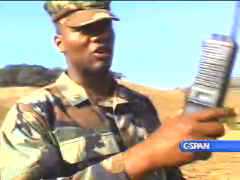

The searchers casually enter the terrorist tent and grab an enemy rucksack without checking it for booby traps or at least using a grappling hook to pull on it from a safe distance to detonate any explosive devices.

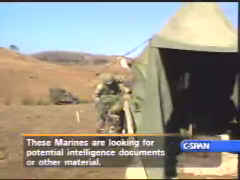

This simulated dead OPFOR soldier has not been searched by ANYONE, his weapon is right by his side! Yet a lone marine plops down in the prone with his M249 Light Machine Gun a few feet away but not even aimed in on the bad guy. This marine could be killed by the bad guy via a knife (think Saving Private Ryan knife fight scene) or a hidden grenade. Or a quick burst from a weapon still in his possession.
Corrections: Search the bad guy with a buddy using proper techniques and he will not have a weapon nearby. The best-known way to search involves the searcher on top of the bad guy's back so if a grenade is found, he can absorb the blast. The security Soldier is out of the searcher's line-of-sight to blast the bad guy to insure he is dead.
All Soldiers should have a "Ranger buddy"--a teammate the follows him wherever he goes. This is not usmc standard, but could also prevent folks getting lost and dying like L/CPL Jason Rother did at 29 Palms in 1988.
Taking too much time on the objective
Good enemies will have on-call mortars and artillery that can land on a position after they withdraw; killing the attackers. By using ad hoc actions created by the whim of leaders instead of rehearsed battle drills, much time is wasted, exposing the entire raid force to enemy retaliatory fires.
Corrections: train to spend no more than 15 minutes on a small raid objective by crisp and precise actions via sound TTP and rehearsals.
Lack of Leader control: cannot assemble the men quickly
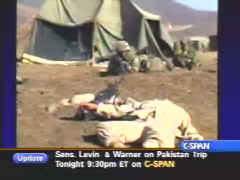
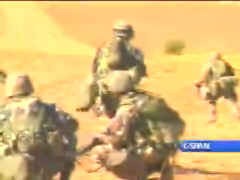
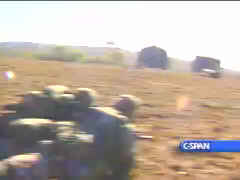
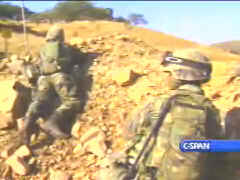
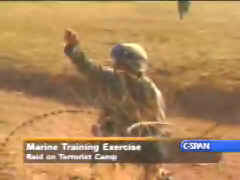
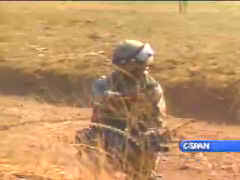
Without a well-rehearsed plan and men to execute it, the squad leader is running around trying to gain control and make-up-a-plan-as-he-goes-along: by yelling and screaming. Imagine what this would be like at NIGHT and in COMBAT with the enemy shooting at them? Its likely he will get hit by enemy fire and killed standing up and running around, leaving followers without-a-clue-what's-going-on to fend-for-themselves.
Corrections: Rehearse exact actions by all personnel. Employ visual and audible signals that are far easier to see and understand other than yelling and expecting men to hear your words. Have a leader "bump" plan if leaders get wounded or killed, insure every man is FULLY able to take over at least 2 levels up.
Unsound movement back to extraction point
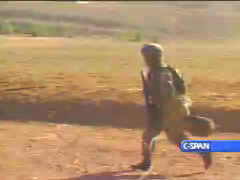

The raid over, the force stops and begins a mad dash to the helicopter extraction point. They now present an excellent target for one enemy terrorist to wipe out the entire "gaggle" with one burst of automatic weapons fire. What would a grenade or landmine do? No flank, rear or point security during movement back to the inbound helicopters. Are weapons even facing outward?
Corrections: a security element should already be in place or gone ahead to guard the helicopters when they land, and the raid force should withdraw back by bounds covered by the other element waiting to bound.
Large, bulky non-folding stretchers

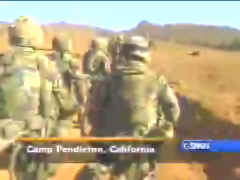
Navy Corpsman (?) is handicapped lugging around a 7-foot long stretcher when folding stretchers or better yet All-Terrain All-purpose Carts (ATACs) are available by NSN through the supply system. Only one man is needed to move a wounded marine by ATAC, but up to 2-4 men's worth of combat power can be lost using a stretcher.
Details
www.reocities.com/pentagon/5265/atac.htm
Where is his helmet?
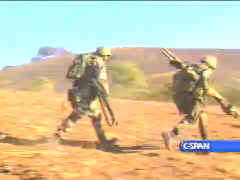
Here the marines are running to the open, exposed rear ramp of a CH-46 helicopter. One has lost his helmet and it looks like his weapon.
Just a mistake made in training? Think again. November 29, 2001, marines in Afghanistan: where are their helmets?

Here marines walk into the abandoned airbase area carrying their helmets. Would they be able to get them on their heads fast enough to prevent injury in a mortar or rocket attack?
Corrections
Landed Helicopters not guarded
As the helicopters land, the marines follow-the-leader into the back and do not take up a temporary perimeter to protect the helicopter as it sits on the ground, rotors turning, engines roaring and vulnerable---enemy can orient on the noise and fire on the helicopters to destroy them.
Corrections: employ same technique used when leaving aircraft--set up temporary perimeter and bound back. Practice it!
Helicopters not armed with door guns

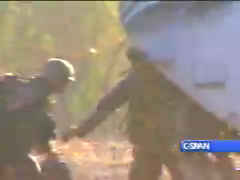
How will crew chief/door gunners perfect with their pilots how best to suppress enemies if machine guns are not taken along during training? Will they learn On-the-Job-Training in combat? What if they fail? Do they get an "F" or a body bag? They get shot down! Re: Vietnam, Grenada...
Corrections: arm helicopters in training.
Self-Serving "everyone was perfect" AAR
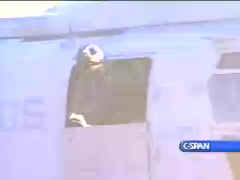
CPT Watson declares the mission a success and offers not a single point of constructive criticism. Nor do any marines come forward with problem areas, all part and parcel to the marine corps culture of smug and unjustified arrogance. CPT Watson offers excuses that the raid would have been done at night and with live ammo to try to head off any potential criticisms. OK, show us footage of these raids done better under those more demanding conditions!
This doesn't wash. At night, the friendly chaos due to poor techniques and ad hocery would have been even worse than it was in the daytime. With live-fire, there would be no living OPFOR, just inanimate targets to shoot at. Even if no marines shot themselves by typically bad fire & movement, this still would prove nothing in terms of what a LIVING enemy fighting for his life could have done to resist them. More convenient validations of Mc institutionalized stupidity.
Notice the shiny, pin-on officer's rank insignia that invites enemy sniper fire from easily detected reflections, U.S. Army insignia, sewn-on to eliminate snagging is in subdued color thread for a tactically sound appearance
Corrections: have REAL After Action Reviews (AAR), Army-style where the TRUTH is sought. Will need a major overhaul of the Mc arrogant mentality to get this. Go to subdued insignia.
Men not taking the AAR seriously: yadda-yadda-yadda the Mc BS
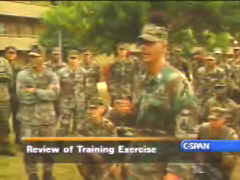
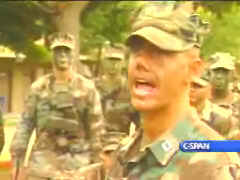
This marine obviously is bored with his Company Commander pontificating about how great he and the unit are. Its likely he wants the AAR over ASAP so he can clean his weapon, shower up and hit the town for a "brewski" and to mingle with the girls of Oceanside, California.
Weapons parkerization worn off, exposing bare metal due to Mc over-cleaning fetish
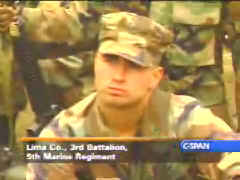
Notice how worn all these weapons are--its not from just use! It's from obsessive cleaning! To get the unrealistic standard of cleanliness required in the marines, the use of abrasives (bore brushes, stripper clips, WD-40 etc.) takes off the parkerized black finish from the weapons, making them vulnerable to rust, corrosion and metal fatigue/breakage which is far more dangerous to weapons function than some faint traces of carbon. These are fairly new weapons but the Mc will try to use their "salty" condition as a bragging point to declare their superiority because they have to "make do" with old equipment! Compare the condition of an Army Ranger or Light Infantry Battalion's weapons to a similar-sized Mc infantry unit!
Another negative side effect of the Mc weapons cleaning fetish is that marines will go out of their way to NOT FIRE BLANKS so as to not dirty their weapon up and make more cleaning work for themselves. The assault force when you go back and listen and watch the video did not fire a lot of blanks or are seen changing magazines---a bad habit to have when fire superiority is a must.
Smug, arrogant marines pontificate about how superior they are to U.S. Army and are so perfect as warriors ad nauseum according to their weak view of battlefield TTP
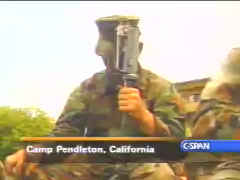
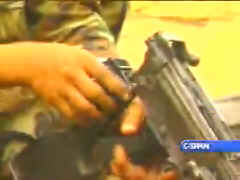
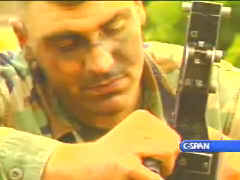
After the exercise, the Lima Company participants explain how they are "superior" warriors ready for combat and better than the U.S. Army is.
By whose standards?
Their own of course!
How convenient.
Those with real-world tactical knowledge are not impressed if they examine Mc practices in detail as this paper documents.
Corrections: Stop brainwashing marines about their superiority at basic training and through dishonest military history. Teach them to be adults with hard-working humility and real honor not make them co-dependant egotists who are filled with narrow-minded hubris.
Cars NOT SEARCHED entering Camp Pendleton; at Fort Bragg they are searched in-detail by armed MPs with M16s. So much for increased "security".
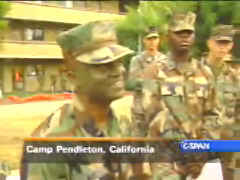
I have painstakingly compared and contrasted the Mc heliborne raid with common sense and better reasoned tactics, techniques and procedures. I have used my inside knowledge from my time in the marines to highlight the institutional biases, which create such failings. They are indeed systemic, and when I saw the video on CSPAN I was aghast, as it was exactly the type of failings I constantly experienced wherever I went in the Mc. The following is an attempt to summarize the basic systemic sins creating this.
The Key Mc Systemic Sins
1. Bad institutional values
The Mc sees itself as an assault force from the sea derived from its storming ashore from U.S. Navy amphibious ships, heavily defended pacific beaches in WWII and gaining lots of positive American publicity for successes despite tactical ineptitude made possible at the cost of thousands of American dead. Taking heavy casualties but glorifying and excusing away the failure by focusing on the heroism of the individual men to further the institution before Congress and the American public, the Mc teaches blind obedience in order to order men forward to achieve local mass as a virtue. WWII was actually a curse to the Mc, with Korea as a mistaken validation of a lemming ethos when it was actually lucky circumstance that seasoned, practical experience in the form of WWII veterans was able to be recalled to active duty. However, the charge! and pile on! attitude of ad hoc has endured beyond the majority of WWII veterans who know better and has permeated the organization from basic training as the cure-all to any and all battlefield problems. Respecting the enemy and what he can do is not factored into how marines fight through better techniques, plans, equipment and prudent countermeasures, as its thought these will only hamper the mass ad hoc effect. Also tied in with blind obedience is a macho pecking order of "who the hell are you?" such that the talents and skills of individuals and even the honest reporting of what they observe are not welcomed and valued to better the organization. Every issue is seen as a question of personal worth/resume' of the good faith messenger instead of the merits of the problem at hand (message). This climate is comfortable for co-dependants who want an institutional parent to validate their worth by conformity, but is a dangerous creator of listless mobs when the local leader figure is gone and they have to think and act for themselves.
2. Ad hocery
"The Mc has gotten along great by improvising, so why should it change now?" Or so goes the common myth. As long as the Mc propaganda machine covers up failures like the Beirut suicide truck bombing that killed 265 with excuses, there will be no repudiation of ad hocery in favor of reasoned and smart TTP. Look at the Mc pubs, there isn't even a TTP for creating fighting positions with overhead cover! If there is, its not trained on. "We are marines we do not need any we will always be on the attack! let the Army defend" is the smug mantra.
3. "Strawman" OPFOR
Because its not considered important to understand and know the enemy since Mc mass and gung ho (should mean Evans Carlson's work together but now means be an obedient follower with a good military appearance imbued with delusions of marine superiority) is going to overwhelm them, OPFOR is usually done by the temporary selection of a friendly unit ad hoc instead of training up and equipping a selected unit to study and best emulate the enemy. That the OPFOR is easily defeated in training exercises should come as no surprise and the scene in Heartbreak Ridge where the OPFOR die on cue by not exercising any initiative is not far from the truth, just reflect on the CSPAN video!
Possible enemy Courses Of Action (COA) are not war-gamed even during the troop-leading process or the sand table briefing via an asking of "what ifs".
4. Bad equipment
With institutional fatalism towards battle, the Mc has purchased and operated large, unarmored cargo helicopters to do heliborne assault operations in order to get mass--a squad or larger sized units into battle per aircraft and not be concerned with survival. This is despite warnings from U.S. Army Air Assault leaders like General Tolson that such large aircraft are extremely vulnerable to enemy small-arms and RPG fire, and to assault using smaller, more robust-sized helicopters flying into smaller, more unpredictable landing zones:
"The Army's decision to standardize on a utility tactical transport helicopter has far-reaching implications on every operation from its planning to its execution. Literally hundreds of our key battles could not have been fought without a light, agile machine that could go into improbable landing zones at a critical time. Had the Army chosen to build its airmobile tactics around a 'platoon carrier', different and less flexible tactics would have been forced on our commanders. As we move to replace the Huey fleet, we must never lose sight of the essential characteristics that made the Huey invaluable to the Infantry commander. Technology offers so many tempting alternatives that one can easily forget the basic problems of squad tactics. The vital lessons which we learned in the 'sizing' of our helicopter fleet dare not be forgotten.
"Late in 1956 the Department of the Army announced plans to replace the H-37 helicopter, which was powered by piston-driven engines, with a new, turbine-powered aircraft. A design competition was held and, in September 1958, a joint Army-Air Force source selection board recommended that the Army procure the Boeing Vertol medium transport helicopter. However, the necessary funds to proceed with full-scale development were not available and the Army vacillated in its design requirements. There were those in the Army who felt that this new helicopter should be a light tactical transport aimed at the mission of the old H-21's and H-34's and, consequently, sized for approximately fifteen troops. Another faction believed that the new transport should be much larger to serve as an artillery prime mover and have minimum interior dimensions compatible with the Pershing Missile system. This 'sizing' problem was a critical decision.
The first Vertol prototype, called the YHC-1A, was tested by the Army to derive engineering and operational data. Three aircraft were built with a maximum troop capacity of twenty. This model eventually became Vertol's commercial 107 and the Marine Sea Knight. However, the YHC-1A was considered by most of the Army users to be too heavy for the assault role and too light for the transport role. The decision was made to procure a heavier transport helicopter and at the same time upgrade the Huey as a tactical troop transport. This decision was to determine the pattern of airmobile operations for the next decade. As a consequence, the Army concept of air assault operations differed from the Marines because, among many reasons, the very nature of the equipment demanded different methods of employment."
The Army tries not to overload too many Soldiers and rucksacks in its UH-60 Blackhawks (successors of the Huey), and their crash-worthy seats have saved hundreds of lives; similar crashes in marine helicopters have KILLED dozens of marines. Since Vietnam, the large, unarmored CH-46 and CH-53 type helicopters have been devastated by enemy fires in numerous operations with large losses of life: Helicopter Valley, Koh Tang island, Desert One and Grenada. Mc emphasis on ship-to-shore movement slants them towards large fuel payloads for range resulting in tactically vulnerable large aircraft, a practice continued in the quest to field the fatally flawed V-22 tilt-rotor aircraft which cannot descend quickly without flipping over due to Vortex Ring State losing rotor lift on one side.
Just a mistake made in training? Think again. November 29, 2001, marines in Afghanistan: packed like sardines combat-loaded rucksacks in America's LARGEST helicopter: the CH-53E
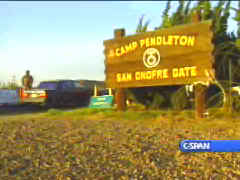
With institutional survival hanging in the balance, the Mc has wed itself to obsolete WWII-style Navy amphibious surface ships in order to guarantee at least some part of the Mc might be forward deployed to get "a piece of the action" in a crisis. Now that these type surface ships are vulnerable to myriad missile, mine and subsurface attacks, they have had to move to over-the-horizon to avoid line-of-sight targeting, adding over 100 miles of travel distance to already range-challenged helicopters. That the Mc recently in Afghanistan had a friendly base in Pakistan to refuel to get there does not cover up the fact that large, unarmored helicopters or tilt-rotors are ill-suited for insertions and extractions of troops in mountainous terrain where close range ambush is likely.
5. Bad doctrine and TTP
Who needs TTP? We are marines.
6. Blind obedience
Shut up and do what you are told! Do not think!
7. Follow-the-leader
You are kept in the dark so you totally depend on your leaders.
8. No force protection
We are in the assault, casualties are inevitable, move on! Is the mindset
9. Half-ass training
The enemy is lesser beings: "ragheads", "slopeheads", etc. etc.
10. Circular reasoning
marines like to point out how they executed training "by the book". Well the Mc's books are *****ed up. Its not only in many places wrong and stupid, it's supposed to be a GUIDE anyway! If your **** is weak and then say you are great because you followed your **** to the letter---that's circular reasoning. It's totally disconnected from REALITY.
11. Arrogance
The killer is that after all of this, the marine in need of feeling good about himself smugly proclaims that because he did stupid things with vigor he is great and superior to all other warriors on earth. Its a dangerous attitude in a dangerous world where real bad guys shoot back at you and are cunningly coming up with unexpected ways to kill you. The creatively evil 9/11 attacks on America of hijacking then ramming airliners into buildings should have alerted the Mc that it is far from being a "911" force.
The enemy is a human being made in God's image with creative abilities even if they are evil. But the marine doesn't know this because his self-worth, in fact all self-worth is tied up in whether they are marines or not. Yes, marines are brain-washed into this mindset in basic training and its high time we rebuke this mentality and show the disease in action, and how it can bring about battlefield disasters (Beirut, Koh Tang, Desert One) or simulated in the recent Lima Company "dog and pony" show for CSPAN.
The statements of the marines at the end of the video segment about how they are marines to prove their personal worth and superiority are sickening to say the least. These mentalities are obstacles for any kind of technotactical humility and excellence.
REFERENCES
1. CSPAN
http://inside.c-spanarchives.org:8080/cspan/cspan.csp?command=dprogram&record=153029050
Vignette ID: 167458 - 11/26/2001 - 0:44 - $29.95
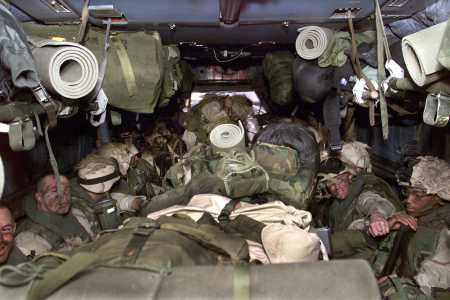
Marine Training Exercise
C-SPAN
Camp Pendleton, California (United States)
Pictures/Persons/091694/091694-167458.jpg Batson, Carrie High, Willie
Christy, Charles Pictures/Persons/091694/091694-167458.jpg
Pictures/Persons/091694/091694-167458.jpg
Pictures/Persons/091695/091695-167458.jpg Pictures/Persons/091695/091695-167458.jpg
Pictures/Persons/091695/091695-167458.jpg
Pictures/Persons/091696/091696-167458.jpg Pictures/Persons/091696/091696-167458.jpg
Pictures/Persons/091696/091696-167458.jpg
Prior to a scheduled deployment, marines trained for a helicopter raid on a mock terrorist camp and talked about their mission and military service.
2. Afghanistan photos of marines
http://search.news.yahoo.com/search/news?p=marines+in+afghanistan&c=news_photos
3. FM 90-4 Air Assault operations
www.adtdl.army.mil/cgi-bin/atdl.dll/fm/90-4/toc.htm
Chapter 3, Section 10
www.adtdl.army.mil/cgi-bin/atdl.dll/fm/90-4/chap3.htm#sec3
GROUND TACTICAL PLAN
3-10. General.
The foundation of a successful air assault operation is the commander's ground tactical plan, around which subsequent planning is based. The ground tactical plan specifies actions in the objective area to ultimately accomplish the mission and address subsequent operations.
4. Lieutenant General John J. Tolson monologue;
Vietnam Studies: AIRMOBILITY 1961-1971
www.army.mil/cmh-pg/books/Vietnam/Airmobility/airmobility-fm.html
Especially:
www.army.mil/cmh-pg/books/Vietnam/Airmobility/airmobility-ch13.html
www.army.mil/cmh-pg/books/Vietnam/Airmobility/airmobility-ch05.html
5. FM 7-8 Infantry Rifle Platoon and Squad
www.adtdl.army.mil/cgi-bin/atdl.dll/fm/7-8/toc.htm
Chapter 2, section 3
www.adtdl.army.mil/cgi-bin/atdl.dll/fm/7-8/ch2.htm#s3p10
2-10. MOVEMENT TECHNIQUES
A movement technique is the manner a platoon uses to traverse terrain. There are three movement techniques: traveling, traveling overwatch, and bounding overwatch. The selection of a movement technique is based on the likelihood of enemy contact and the need for speed. Factors to consider for each technique are control, dispersion, speed, and security (
 RETURN TO MORE USMC BULLSHIT, CAN YOU HANDLE THE TRUTH?
RETURN TO MORE USMC BULLSHIT, CAN YOU HANDLE THE TRUTH?